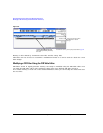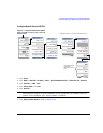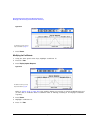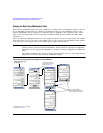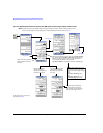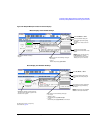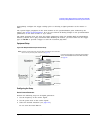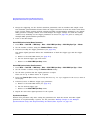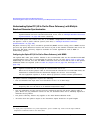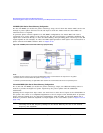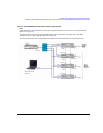
212 Agilent N5161A/62A/81A/82A/83A MXG Signal Generators User’s Guide
Basic Digital Operation (Option 651/652/654) Preliminary
Multiple Baseband Generator Synchronization Preliminary
Understanding the Master/Slave System
System Delay
The multiple BBG synchronization feature provides a system for synchronizing the waveform
generation capability of up to 16 signal generators to within a characteristic value of ± 8 ns between
the master and the last slave. This minor amount of delay (± 8 ns) can be reduced further to
picosecond resolution by using the I/Q Delay softkey located in the I/Q menu. To reduce the delay,
check and adjust the BBG signal alignment for each signal generator in the system. For more
information on adjusting the delay, see “I/Q Adjustments” on page 193.
The delay value includes compensation for cables that have less than 1 ns of propagation delay
between the EVENT 1 and PAT TRIG connectors (see Equipment Setup). The recommended cable is an
Agilent BNC cable, part number 10502A. The use of cables with greater propagation delay may not
allow the signal generators to properly synchronize.
System Synchronization
Synchronization occurs after the master signal generator sends a one–time event pulse that
propagates through and to each slave in the system. Prior to this event, each slave must recognize
that it is waiting for this event pulse, which occurs during the system configuration (see “Configuring
the Setup” on page 213). In order to properly send the synchronization pulse, the trigger source and
the Dual ARB Player for each signal generator must be turned off.
The master/slave setup does not incorporate a feedback system between the slaves and the signal
generator selected as the master. After synchronization, if changes occur to the Multi–BBG Sync
Setup menu or a signal generator is added to the system, the master does not automatically
resynchronize the setup. This may cause the signal generators in the system to incorrectly report
their status as In Sync.
The system can also misinterpret other signals as the synchronization pulse, which results in an
incorrect In Sync status. These types of signals include a continuous trigger or an active Marker
routed to the EVENT 1 connector. Improperly connected rear panel cables can also create a false
status.
You must resynchronize the entire system after making any change in one or all of the Multi–BBG
Sync Setup menus, after adding a signal generator to the system, or in doubt as to the true status of
a signal generator. Changes to parameters that are outside of the Multi–BBG Sync Setup menu such
as waveform files, Dual ARB state, sample rate, scaling, carrier frequency or amplitude have no effect
on the system synchronization. To resynchronize a system, see “Making Changes to the Multiple
Synchronization Setup and Resynchronizing the Master/Slave System” on page 215.
System Trigger Setup
The multiple BBG synchronization feature restricts the trigger selections (see page 210) for each
signal generator. For signal generators selected as slaves, you can only modify the trigger type (with
restrictions). The trigger source is fixed and set to receive a trigger through the rear panel PAT TRIG
connector. On the master, you can change both the trigger type (with restrictions) and the trigger
source. The trigger source provides three options for triggering the waveforms: external trigger, front
panel Trigger key, or the GPIB trigger.
If the trigger settings are other than what the BBG synchronization feature supports, the feature
changes the trigger settings to what is shown on page 210. When this change occurs, the Agilent MXG
generates a settings conflict error to alert you to the changes. To avoid the error generation,



